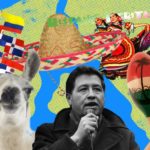| By the U.S. Census Bureau
 About APA Heritage Month About APA Heritage Month
In 1978, a joint congressional resolution established Asian/Pacific American Heritage Week. The first 10 days of May were chosen to coincide with two important anniversaries: the arrival in the United States of the first Japanese immigrants (May 7, 1843) and the completion of the transcontinental railroad (May 10, 1869). In 1992, Congress expanded the 10-day observance to a month-long celebration.
Per a 1997 Office of Management and Budget directive, the Asian or Pacific islander racial category was separated into two different categories: “Asian” and “native Hawaiian or other Pacific islander.”
Asians
Population
14.0 million
The estimated number of U.S. residents in July 2004 who said they were Asian or Asian in combination with one or more other races. This group comprised 5 percent of the total population. California had both the largest population (4.8 million) and the largest numerical increase (123,000) of people of this group since July 2003; Hawaii is the state where Asians made up the highest proportion of the total population (58 percent).
<Census : /archives/population/005164.html>
<Census : /archives/population/005514.html>
3.4%
Percentage growth of the Asian population between 2003 and 2004, the highest of any race group during that time period.
<Census : /archives/population/005164.html>
Education
49%
The percentage of Asians, age 25 and older, who have a bachelor’s degree or higher level of education. Asians have the highest proportion of college graduates of any race or ethnic group in the country. <Census : /archives/education/004214.html>
87%
The percentage of Asians, age 25 and older, who are high school graduates.
<Census : /archives/education/004214.html>
20%
The percentage of Asians, age 25 and older, who have an advanced degree (e.g., master’s, Ph.D., M.D. or J.D.).
<Census : /archives/education/004214.html>
 The Asian population is comprised of many groups who differ in languages spoken, culture and length of residence in the United States. This is reflected in the demographic characteristics of these groups. For instance, 68 percent of Asian Indians, age 25 and older, had a bachelor’s degree or more education and 37 percent had a graduate or professional degree; the corresponding numbers for Vietnamese-Americans were 24 percent and 7 percent, respectively. (Source: American FactFinder) The Asian population is comprised of many groups who differ in languages spoken, culture and length of residence in the United States. This is reflected in the demographic characteristics of these groups. For instance, 68 percent of Asian Indians, age 25 and older, had a bachelor’s degree or more education and 37 percent had a graduate or professional degree; the corresponding numbers for Vietnamese-Americans were 24 percent and 7 percent, respectively. (Source: American FactFinder)
Income and Poverty
$57,518
Median household income for Asians in 2004, the highest among all race groups.
<Census : /archives/income_wealth/005647.html>
Median household income differed greatly by Asian group. For Asian Indians, for example, the median income in 2004 was $68,771; for Vietnamese-Americans, it was $45,980. (Source: American FactFinder)
9.8%
Poverty rate for Asians in 2004, down from 11.8 percent in 2003.
<Census : /archives/income_wealth/005647.html>
Businesses
1.1 million
Number of businesses owned by Asian-Americans in 2002, up 24 percent from 1997.
$343.3 billion
Receipts of Asian-American-owned businesses in 2002, up 13 percent from 1997. An estimated 319,911 Asian-owned businesses had paid employees; and their receipts totaled $307.6 billion, or about $961,379 per firm.
- About 28 percent of Asian-American-owned firms were in health care and other services, with another 14 percent each in professional services and retail trade.
- Asian-American-owned firms accounted for 45 percent of businesses in Hawaii, 13 percent of firms in California and 9 percent in New York.
Source for the statements referenced in the above “Businesses” section:
<Census : /archives/business_ownership/005477.html>
Languages
2.3 million
The number of people age 5 and older who speak Chinese at home. After Spanish, Chinese is the most widely spoken non-English language in the country. Tagalog and Vietnamese also have more than 1 million speakers. (Source: AmericanFactFinder)
Coming to America
8.7 million
The number of U.S. residents who were born in Asia. Asian-born residents comprise one-fourth of the nation’s total foreign-born population.
<Census : /archives/foreignborn_population/003969.html>
52%
The percentage of the foreign-born from Asia who are naturalized U.S. citizens.
<Census : /archives/foreignborn_population/003969.html>
1.8 million
The estimated number of foreign-born people from China. Following Mexico, China is the leading country of birth for the nation’s foreign-born. Other nations contributing at least 1 million foreign-born to our nation include India and the Philippines. The estimate for China includes Taiwan and Hong Kong. (Source: American FactFinder)
Serving Our Nation
282,000
The number of Asian-American military veterans. (Source: American FactFinder)
Families
60%
The proportion of Asian households consisting of a married-couple family. (Source: American FactFinder)
Jobs
46%
The proportion of employed Asians 16 and older who work in management, professional and related occupations, such as financial managers, engineers, teachers and registered nurses. (Source: American FactFinder)
Counties
1.4 million
The number of Asians in Los Angeles County, Calif., which tops the nation’s counties. From 2003 to 2004, this county also experienced the largest numerical increase of Asians (25,200).
<Census : /archives/population/005514.html>
Age Distribution
26%
Percent of people on July 1, 2004, identifying themselves as either Asian or Asian in combination with one or more other races who are under 18; 8 percent are 65 or older.
<Census : /archives/population/005164.html>
The Future
33.4 million
The projected number of U.S. residents in 2050 who will identify themselves as Asians. They would comprise 8 percent of the total population by that year.
<Census : /archives/population/001720.html>
213%
The projected percentage increase between 2000 and 2050 in the population of people who identify themselves as Asian. This compares with a 49 percent increase in the population as a whole over the same period of time.
<Census : /archives/population/001720.html>
Native Hawaiians and Other Pacific Islanders
Population
976,400
The estimated number of U.S. residents in July 2004 who said they are native Hawaiian and other Pacific islander or native Hawaiian and other Pacific islander in combination with one or more other races. This group comprised 0.3 percent of the total population. There were 279,700 native Hawaiians or Pacific islanders in Hawaii, which led all states. Hawaii is also where native Hawaiians and other Pacific islanders made up the largest proportion (22 percent) of the total population. California had the largest numerical increase of native Hawaiians and other Pacific islanders (3,400) since July 2003.
<Census : /archives/population/005164.html>
<Census : /archives/population/005514.html>
1.7%
Percentage growth of the native Hawaiian and other Pacific Islander population between 2003 and 2004, the highest of any race group except for Asians.
<Census : /archives/population/005164.html>
Education
15%
The percentage of native Hawaiians and other Pacific islanders, age 25 and older, who have at least a bachelor’s degree. (Source: American FactFinder)
84%
The percentage of native Hawaiians and other Pacific Islanders, age 25 and older, who are high school graduates. (Source: American Factfinder)
4%
The percentage of native Hawaiians and other Pacific islanders, age 25 and older, who have obtained a graduate degree. (Source: American FactFinder)
Income and Poverty
$51,687
The three-year-average (2002-2004) median income of households whose householders reported their race as native Hawaiian and other Pacific islander, but did not report any other race.
<Census : /archives/income_wealth/005647.html>
13.2%
The three-year average (2002-2004) poverty rate for those who reported their race as native Hawaiian and other Pacific islander, but did not report any other race.
<Census : /archives/income_wealth/005647.html>
Businesses
32,299
Number of native Hawaiian- and other Pacific islander-owned businesses in 2002, up 67 percent from 1997.
$5.2 billion
Receipts for native Hawaiian- and other Pacific islander-owned businesses in 2002, up 26 percent from 1997. An estimated 4,333 native Hawaiian- and other Pacific islander-owned businesses had paid employees; their receipts totaled $4.3 billion, or about $998,481 per firm.
- Native Hawaiian- and other Pacific islander-owned businesses were fairly well distributed across business sectors, with between 10 and 15 percent in each of the following: health care; other services; administrative and support and waste management; professional services; retail trade; and construction.
- Native Hawaiian- and other Pacific islander-owned businesses accounted for less than 1 percent of firms in all states except Hawaii, where 9 percent were owned by native Hawaiians and other Pacific islanders.
Source for the statements referenced in the above “Businesses” section:
<Census : /archives/business_ownership/005477.html>
Languages
27,160
The number of people in 2000 who spoke Hawaiian at home. <Census : //socdemo/lang_use.html>
Serving Our Nation
30,700
The number of native Hawaiian and other Pacific islander-American military veterans.
(Source: American FactFinder)
Families
53%
The proportion of native Hawaiian and other Pacific islander households containing a married-couple family. (Source: American FactFinder)
Jobs
23%
The proportion of employed native Hawaiians and other Pacific islanders 16 and over who work in management, professional and related occupations, such as financial managers, engineers, teachers and registered nurses. (Source: American FactFinder)
Counties
183,200
The number of native Hawaiians and other Pacific islanders who live in Honolulu County, Hawaii, which has the largest population of this race of any county in the nation. Clark County, Nev., registered the largest numerical increase of native Hawaiians and other Pacific islanders (1,100) between 2003 and 2004. <Census : /archives/population/005514.html>
Age Distribution
32%
Percent of people identifying themselves as either native Hawaiian and other Pacific islander or native Hawaiian and other Pacific islander in combination with one or more other races who are under 18; 6 percent are 65 or older.
<Census : /archives/population/005164.html>
Note: American Community Survey estimates are based on the population of one race only and do not include those living in group quarters.
CB06-FF.06
March 27, 2006
|

 About APA Heritage Month
About APA Heritage Month The Asian population is comprised of many groups who differ in languages spoken, culture and length of residence in the United States. This is reflected in the demographic characteristics of these groups. For instance, 68 percent of Asian Indians, age 25 and older, had a bachelor’s degree or more education and 37 percent had a graduate or professional degree; the corresponding numbers for Vietnamese-Americans were 24 percent and 7 percent, respectively. (Source: American FactFinder)
The Asian population is comprised of many groups who differ in languages spoken, culture and length of residence in the United States. This is reflected in the demographic characteristics of these groups. For instance, 68 percent of Asian Indians, age 25 and older, had a bachelor’s degree or more education and 37 percent had a graduate or professional degree; the corresponding numbers for Vietnamese-Americans were 24 percent and 7 percent, respectively. (Source: American FactFinder)









